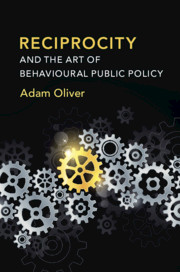Book contents
- Reciprocity and the Art of Behavioural Public Policy
- Reciprocity and the Art of Behavioural Public Policy
- Copyright page
- About the author
- Dedication
- Contents
- Figures and Tables
- Preface
- Acknowledgements
- 1 Setting the Scene
- 2 Animals and Infants
- 3 A Pinch of Anthropology
- 4 A Dash of Behavioural Economics
- 5 The Domain of Reciprocity
- 6 The Dark Side of Reciprocity
- 7 Nurturing Reciprocity in Public Policy
- 8 Reciprocity-Informed Policy Design
- 9 Towards a Political Economy of Behavioural Public Policy
- 10 Summing Up
- References
- Index
10 - Summing Up
Published online by Cambridge University Press: 06 July 2019
- Reciprocity and the Art of Behavioural Public Policy
- Reciprocity and the Art of Behavioural Public Policy
- Copyright page
- About the author
- Dedication
- Contents
- Figures and Tables
- Preface
- Acknowledgements
- 1 Setting the Scene
- 2 Animals and Infants
- 3 A Pinch of Anthropology
- 4 A Dash of Behavioural Economics
- 5 The Domain of Reciprocity
- 6 The Dark Side of Reciprocity
- 7 Nurturing Reciprocity in Public Policy
- 8 Reciprocity-Informed Policy Design
- 9 Towards a Political Economy of Behavioural Public Policy
- 10 Summing Up
- References
- Index
Summary
This final chapter summarises the arguments and evidence presented in the previous nine chapters - it is thus, in the main, a collection of short summaries of those chapters. The chapter finishes off by contending that the notion that we ought to, and often do, reciprocate is one that most people can accept. It is acknowledged once again that there are many possible dark sides to reciprocity, but that it more often than not serves the better angels of our nature, and in the process generates significant group and, by extension, individual benefits. Consequently, it is advised that policies, institutions, organisations and sectors should be designed to encourage and sustain this most fundamental motivator of human behaviour.
- Type
- Chapter
- Information
- Reciprocity and the Art of Behavioural Public Policy , pp. 166 - 177Publisher: Cambridge University PressPrint publication year: 2019

